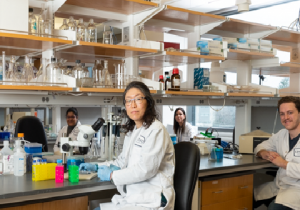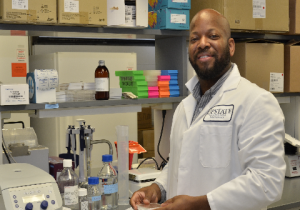Home

With the resources of the SUNY Research Foundation, and our history of successful partnerships, we are here to help move biomedical products and ideas to market.

Our scientists and core facilities can help move discoveries into practice and technologies into the marketplace.

Upstate is home to top research facilities with highly specialized equipment and advanced instrumentation, to support research and product development.

We are here to create the relationships and partnerships needed to move innovative ideas forward.
Upstate Biotech Ventures
In a partnership between Empire State Development, Upstate Medical University, the SUNY Research Foundation, and Excell Partners, the newly-launched Upstate Biotech Ventures invests in high-potential startups and small businesses affiliated with Upstate Medical University to drive research and technology innovation.
Recent Tech from SUNY Upstate

Antibody against Endoplasmic reticulum lipid raft associated 1 (Erlin-1; also known as anti-KE04 and...
Antibody against Endoplasmic reticulum lipid raft associated 1 (Erlin-1; also known as anti-KE04 and anti-SPFH) Background: Erlin1 (endoplasmic reticulum lipid raft associated 1) is part of a protein complex that mediates degradation of inositol 1,4,5-trisphosphate receptors in the endoplasmic reticulum. The encoded protein also binds cholesterol and regulates the SREBP signaling pathway, which promotes cellular cholesterol homeostasis. Defects in this gene have been associated with spastic paraplegia 62. https://www.ncbi.nlm.nih.gov/gene/10613 Technology Overview:
- Polyclonal, affinity-purified
- Immunogen: amino acids 332-346 of rat Erlin-1
- Western blot
- ELISA
- Immunoprecipitation
- Immunofluorescence assays

Novel luciferase reporter provides optimal performance in high-throughput screens of G-protein-coupl...
Novel luciferase reporter provides optimal performance in high-throughput screens of G-protein-coupled agonist binding.Background: G-protein-coupled receptors (GPCRs) constitute the largest class of cell surface receptors. GPCR genes account for 5% of the human genome. GPCRs also represent the largest and among the most efficacious classes of therapeutic targets for diseases including cardiovascular disease, cancer, and asthma. Technology Overview: The novel cyclic adenosine monophosphate (cAMP)-responsive luciferase reporter exhibits optimal performance in high-throughput screens of agonist binding at GPCRs. This reporter exhibits substantially reduced basal activity, a feature that is likely to be of particular importance when performing high-throughput screens in which false-positive hits are to be avoided. Compared to other reporters, the present construct affords a much wider dynamic range of activation (>340 fold-stimulation) upon exposure to GPCR agonists with cAMP signaling properties. https://suny.technologypublisher.com/files/sites/2009-110.jpghttps://www.pexels.com/photo/scientist-in-laboratory-3735769/ Advantages:
- Significantly reduced basal luciferase activity inherent to similar reporters.
- Wide dynamic range of activation upon exposure to agonist.
- Research tool
- Drug candidate high-throughput screening
.jpeg)
A nanocarrier platform for Amphotericin B that improves efficacy and reduces cost, while decreasing...
A nanocarrier platform for Amphotericin B that improves efficacy and reduces cost, while decreasing toxicity. Background:
Systemic fungal infections are an increasingly prevalent health problem. The hydrophobic polyene antibiotic Amphotericin B (AmB) is the drug of choice for these life-threatening invasive fungal infections. Unfortunately, it produces dose-limiting side effects such as nephrotoxicity. For example, Fungizone® is a conventional sodium deoxycholate micellar formulation of AmB that exhibits high nephrotoxicity and infusion-related reactions. Clinically approved liposomal formulations of AmB, such as AmBisome, reduces AmB toxicity, but do not offer better clinical efficacy. Numerous nanoformulations have been developed for AmB delivery to improve the efficacy and reduce toxicity and cost. However, current options cannot enable the fine-tuning of AmB aggregation in a nanocarrier, which is directly associated with the efficacy and toxicity of AmB formulation for clinical translation.Technology Overview:
This technology is a PEGylated linear-dendritic telodendrimer (TD) nanocarrier platform for customized nanocarrier design. Different hydrophobic groups can be freely introduced on the dendritic periphery of TD to fine-tune the hydrophobicity and flexibility of the core structure of micelle to control AmB molecular aggregation. The AmB aggregation status in this nanoformulation has a positive correlation with the haemolytic activity and a reverse correlation with antifungal activity. The optimized nanoformulation, with the highest monomeric AmB, significantly improves the antifungal activities and reduces the toxicity both in vitro and in vivo in comparison to Fungizone and AmBisome. This offers significant promise for clinical translation with increased therapeutic window and reduced cost in comparison to the lipid formulations (e.g. AmBisome). https://suny.technologypublisher.com/files/sites/adobestock_436803475_(002).jpegAdvantages:
- Decreases toxicity compared to other AmB options.
- Increases clinical efficacy.
- Reduces cost.
The primary application for this technology is the development of AmB therapeutics for the treatment of fungal infections. Intellectual Property Summary:
Provisional Patent Application 63/441,993 filed on 1/30/2023
Stage of Development:
TRL 3 - Experimental proof of concept Licensing Status:
This technology is available for licensing.Licensing Potential:
This technology would be of interest to anyone involved in the development of treatments for fungal infections based on AmB, including:
- Pharmaceutical companies
- Medical research centers
- Hospitals
- Universities

A suite of nanocarrier technologies that provide targeted drug delivery of hydrophobic and hydrophil...
A suite of nanocarrier technologies that provide targeted drug delivery of hydrophobic and hydrophilic drugs to specific disease sites. Background:
Delivery of therapeutic and diagnostic compounds is limited by the lack of efficient carriers to improve in vivo stability, selectivity as well as to reduce immunogenicity. Conventional nanocarrier design generally follows a “trial and error” approach using a limited number nanoparticle types to fit a variety of drug molecules that exhibit substantial chemical variation. This approach results in suboptimal nano-formulations with compromised efficiency for in vivo drug delivery and decreased probability of successful clinical translation. In contrast, the suite of innovations described herein offer a customized nanocarrier platform with the capability of structure-based design and systematic optimization to bridge the gap for nanomedicine in clinical translation.Technology Overview:
This innovative technology portfolio from Upstate Medical University provides multiple chemical formulations of telodendrimer nanoparticles made from biocompatible polyethylene glycol, amino acids, and natural compounds. The resulting nanoparticles results in the biocompatible and effective delivery of various therapeutic drugs for targeted disease treatments. Telodendrimer refers to a linear-dendritic copolymer, containing a hydrophilic segment (i.e., PEG or poly/oligo zwitterionic moieties) and one or more dendritic domain with the peripheries covalently conjugated with well-defined chemical moieties selected based on the affinities specifically to the drug molecule to be delivered. Such end groups are selected based on the chemical structure of the chosen therapeutic drug and can be optimized via a systematic combinatorial approach.
Drugs that can be sequestered in the customized nanocarriers or linked to the conjugates include, but are not limited to, anticancer drugs: taxanes, Doxorubicin, Platinum drugs, topoisomerase II inhibitors, topoisomerase I inhibitors, tubulin interacting agents, hormonal agents, thymidylate synthase inhibitors, anti-metabolites, alkylating agents, aromatase inhibitors, and antibiotics: e.g. polymyxin, gentamycin, tetracycline drugs, amphotericin, and immune-modulating drugs: methotrexate, dexamethasone, curcumin, tetracycline and derivatives, etc.
https://suny.technologypublisher.com/files/sites/110-2024.jpg
Advantages:
• Stable drug formulations with small nanoparticle sizes (20-30 nm);
• In vitro and in vivo extended half-life stability;
• Efficient disease targeting drug delivery;
• Capability for intracellular delivery;
• Capability for encapsulating high amounts of drug molecules (10%-100% of drug/nanoparticles by weight);
• The ability to protect bioactivity with reduced toxicity of current cancer treatments;
• Well-defined structure for reproducibility; and
• Provides a systematic approach for nanocarrier optimization based on drug structure to meet FDA regulations and thereby improve potential for clinical translation. Applications:
• Drug Delivery for hyperproliferative disorders including cancer
• Delivery of antibiotics for infectious disease
• Drug delivery for other disorders including inflammatory or allergic diseases, autoimmune diseases, graft rejection and other diseases where undesired inflammatory responses need to be inhibited
Intellectual Property Summary:
• Functional Segregated Telodendrimers and Nanocarriers and Methods of Making and Using the Same - US 2017/0252456 A1
• Telodendrimers with Riboflavin Moieties and Nanocarriers and Methods of Making and Using the Same - WO2018136778A1 and US20190328742A1
• Zwitterionic Dendritic Amphiphiles, Zwitterionic Dendrimers, Zwitterionic Telodendrimers, Nanocarriers Comprising the Same, and Methods of Making and Using the Same - WO2018160759A1 and US20200009069A1
• Telodendrimers and Nanocarriers and Methods of Using the Same: EP3035968B1 and U.S.20150056139A1
Stage of Development:
In vivo and ex vivo studies in cancer and inflammation mouse models have been completed.
Licensing Status:
Seeking an industry partner to license the technology or partner to further technical development.
Additional Information:
• Guo, D., Shi, C., Wang, L., Ji, X., Zhang, S. & Luo, J.* Rationally Designed Micellar Nanocarriers for the Delivery of Hydrophilic Methotrexate in Psoriasis Treatment. ACS Applied Bio Materials (2020), 3, 8, 4832–4846. https://pubs.acs.org/doi/10.1021/acsabm.0c00342
• Guo D, Shi C, Wang X, Wang L, Zhang S, Luo J.* Riboflavin- containing telodendrimer nanocarriers for efficient doxorubicin delivery: High loading capacity, increased stability, and improved anticancer efficacy. Biomaterials. 2017 Oct;141:161-175. https://www.sciencedirect.com/science/article/pii/S0142961217304489?via%3Dihub
• Wang L, Shi C, Wright FA, Guo D, Wang X, Wang D, Wojcikiewicz RJH, Luo J.* Multifunctional Telodendrimer Nanocarriers Restore Synergy of Bortezomib and Doxorubicin in Ovarian Cancer Treatment. Cancer Res. 2017 Jun 15;77(12):3293-3305. https://cancerres.aacrjournals.org/content/77/12/3293.lon
• Shi C, Guo D, Xiao K, Wang X, Wang L, Luo J.* A drug-specific nanocarrier design for efficient anticancer therapy. Nat Commun. 2015 Jul 9;6:7449. doi: 10.1038/ncomms8449. https://www.nature.com/articles/ncomms8449
• Xu G, Shi C, Guo D, Wang L, Ling Y, Han X, Luo J.* Functional- segregated coumarin-containing telodendrimer nanocarriers for efficient delivery of SN-38 for colon cancer treatment. Acta Biomater. 2015 Jul;21:85-98. doi: 10.1016/j.actbio.2015.04.021. https://www.sciencedirect.com/science/article/abs/pii/S1742706115001920?via%3Dihub
• Huang W, Wang X, Shi C, Guo D, Xu G, Wang L, Bodman A, Luo J.* Fine-tuning vitamin E-containing telodendrimers for efficient delivery of gambogic acid in colon cancer treatment. Mol Pharm. 2015 Apr 6;12(4):1216-29. doi: 10.1021/acs.molpharmaceut.5b00051. https://pubs.acs.org/doi/10.1021/acs.molpharmaceut.5b00051
• Cai L, Xu G, Shi C, Guo D, Wang X, Luo J.* Telodendrimer nanocarrier for co-delivery of paclitaxel and cisplatin: A synergistic combination nanotherapy for ovarian cancer treatment. Biomaterials. 2015 Jan; 37:456-468. doi: 10.1016/j.biomaterials.2014.10.044. https://www.sciencedirect.com/science/article/pii/S0142961214010928?via%3Dihub
• Shao Y, Shi C, Xu G, Guo D, Luo J.* Photo and redox dual responsive reversibly cross-linked nanocarrier for efficient tumor- targeted drug delivery. ACS Appl Mater Interfaces. 2014 Jul 9;6(13):10381-92. doi: 10.1021/am501913m. https://pubs.acs.org/doi/10.1021/am50191




